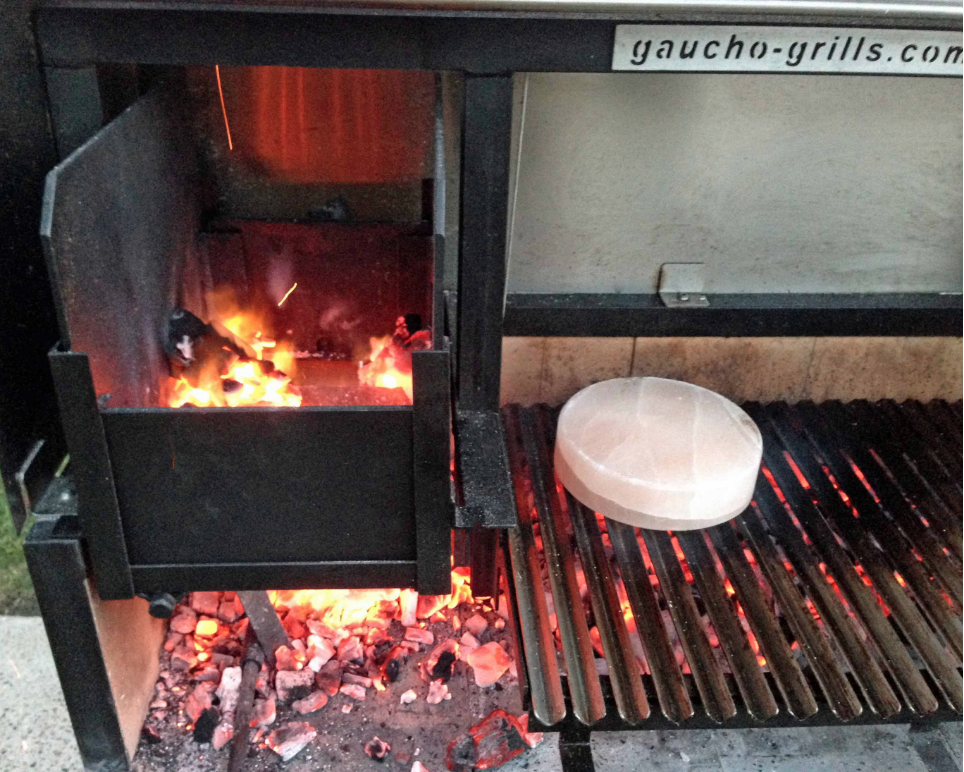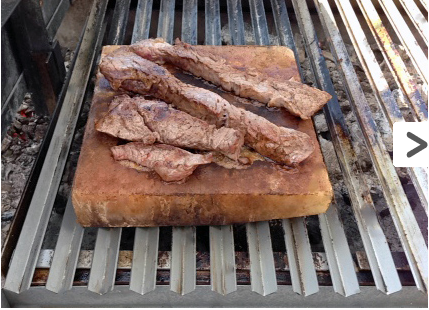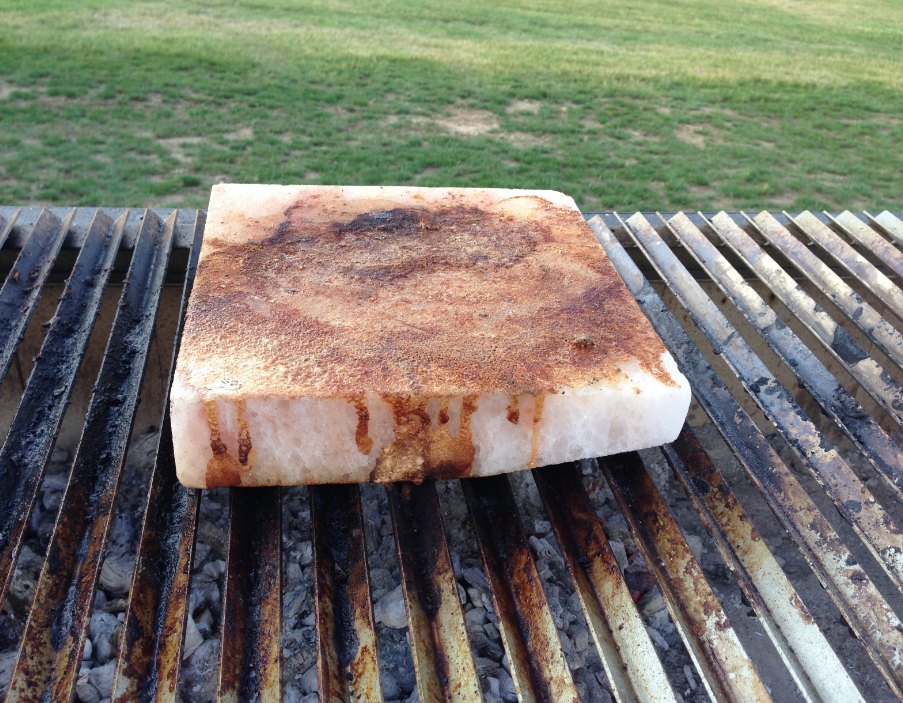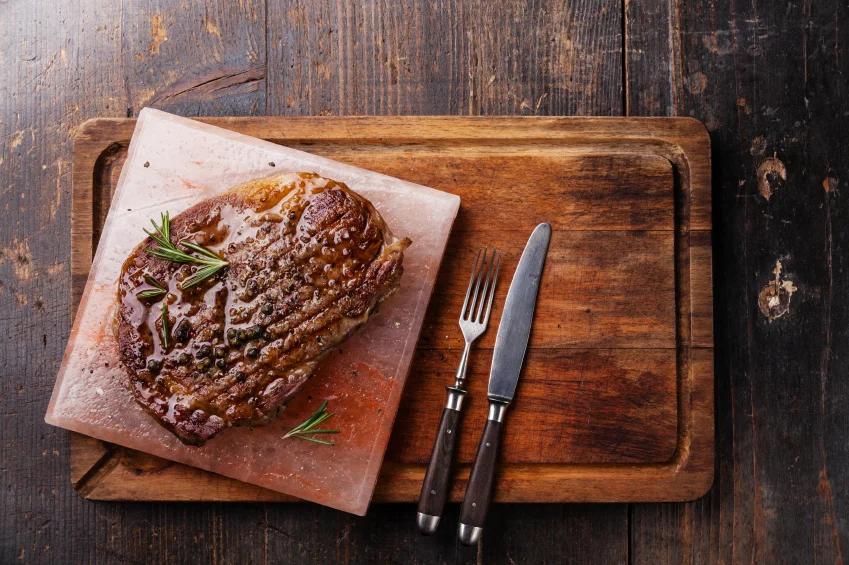Grilling with your Himalayan Salt Block
Although used for thousands upon thousands of years, (See the Book of Job reference) today it seems like the use of salt has exploded in popularity more than ever. Try to find a seasoning or condiment that doesn’t advertise: “Made with all-natural sea salt.” Look and see how many pretty salt colors and flavors there are in your local spice shop or even grocery store. There are colored salts, flavored salts, smoked salts, salt cured meats, salt encrusted meats and fish, and on it goes. It’s even a hit in our desserts and coffees with “Sea-Salt Caramel” flavored everything.
So it was no surprise to us when we discovered the wonderful world of salts has now permeated into the grilling arena. Yes there are a thousand and one ways to season any of your grilled fare to perfection with salts. Recipes abound that call for all sorts of extravagant salted marinades and rubs. In addition, there perhaps is no better way to prepare a juicy grilled steak than to season it with a minimalist approach of some coarse kosher salt and cracked black pepper. However we’ve recently come to embrace the fantastic salt infusing method of grilling on top of a Pink Himalayan Salt Block. For a salt lover, this is truly a unique way to go.
“Can something tasteless be eaten without salt, or is there any taste in the white of an egg?” – Job 6:6
Although used for thousands upon thousands of years, (See the Book of Job reference) today it seems like the use of salt has exploded in popularity more than ever. Try to find a seasoning or condiment that doesn’t advertise: “Made with all-natural sea salt.” Look and see how many pretty salt colors and flavors there are in your local spice shop or even grocery store. There are colored salts, flavored salts, smoked salts, salt cured meats, salt encrusted meats and fish, and on it goes. It’s even a hit in our desserts and coffees with “Sea-Salt Caramel” flavored everything.
So it was no surprise to us when we discovered the wonderful world of salts has now permeated into the grilling arena. Yes there are a thousand and one ways to season any of your grilled fare to perfection with salts. Recipes abound that call for all sorts of extravagant salted marinades and rubs. In addition, there perhaps is no better way to prepare a juicy grilled steak than to season it with a minimalist approach of some coarse kosher salt and cracked black pepper. However we’ve recently come to embrace the fantastic salt infusing method of grilling on top of a Pink Himalayan Salt Block. For a salt lover, this is truly a unique way to go.
Why is a Salt Block Great for Grilling?
Asado grilling salt blockThe block of choice for us at Gaucho Grills is a 2” thick cut of pink marbled salt mined from the Himalayan mountain region. The thicker the block, the better the quality, the longer it will last, and the better the heat retention.
The beautiful pink coloring to these salt blocks not only makes it a nice presentation or serving vehicle, but is indicative of the mineral composites left in the salt itself. These minerals can have added health benefits over your traditional iodized white salts. The minerals also offer a more distinct flavor profile for those palates able to discern the mineral flavors embedded in the salt. (We know for some salt is just salty and that can be good as well.)
The key to grilling on these blocks is HEAT. Notice the emphasis, because if the block doesn’t get hot enough to sear your meat to it could very well ruin it. (A useful tool to measure the temperature of your grilling surface, and in this case, the salt block, is a simple infrared thermometer. Just point the little laser and scan the readout. I wouldn’t drop a piece of meat on the block until I at least see 375 degrees or higher.)
Once the block is hot enough to make your meat sizzle, drop a piece of unseasoned (at least unsalted) meat of choice and cook on it as you would a cast iron pan. The block is good for most any cut of meat. Steak is amazing but we’ve tried chicken, fish and shellfish, all with fantastic results.
With the meat cooking on the block, the juices will flow and you will start to see that pretty pink color start to turn brown as the salt block starts it’s seasoning process. Over time the meat juices will wear down the block, but a two inch thick slab of Himalayan salt should last quite a while. We’ve gotten entire grilling seasons out of one block even with weekly usage.
The cook time of the meat will vary on the cut and type of meat, but mostly on your saltiness taste preference. For steaks I like to hit each side for 5 minutes to impart the salt level I prefer. This is the part that will take some fun grilling practice, finding that perfect salt level to your taste.
Please know that the salt flavor will not just coat the top of the steak. The salt does infuse into the steak as it cooks. As the moisture of the meat releases, it draws in the salt flavor. That is why the heat is so critical. If the block is not hot enough, the meat will release its moisture but not sear properly. This will in affect draw in too much of the salt flavor and you will find your meat overly salty (we learned this the hard way with a bad scallop experience).
If you feel that you’ve grilled with your block long enough and your salt level has been reached but your meat is still not done to your preference, simply take your meat off the block and finish it on the grill. You can even work that process in reverse. Meat can be started on the grill and then finished off on the block if you desire.
Cleaning Your Pink Himalayan Salt Slab
cleaning parrilla salt blockAfter your fantastic grilled meal, it’s time to clean up your grilling area. With a Pink Himalayan Salt Slab, the cleaning is easy. The first step is the crucial one. Make sure, the block has cooled off enough that it’s safe to handle. These blocks retain heat very well and the block can be too hot to handle even if the rest of your grill has long cooled off. Once the block is cooled, wipe off any residue still stuck to the block.
After the larger residue is removed, a damp towel can be used to remove any of the finer residue and oils left behind. This water can add to the deterioration of the salt so use sparingly and wipe quickly followed by a thorough drying pat down after you’re done. With the block dry and free from moisture, wrap in a towel or stow in a plastic container. Keep the block stored in a dry area of your home. That’s it. No washing, soaking, soap or hassles. The ease of cleaning is found in the anti-bacterial properties of salt itself. Wipe off the junk, the salt will kill the rest. (Not to mention the 400+ degrees the next time you fire it up.)
The Pink Himalayan Salt Block is another culinary tool in your arsenal that can enhance your grilling experience. There are other ways to use the block around the kitchen as well. Blocks can be heated in the oven and used to cook table side. The temperature retention of the blocks are amazing. The blocks hold cold just as well as they hold the heat. Try freezing your block and use it as a beautiful serving tray for meats and shell fish. The anti-bacterial properties of the salt block are a perfect safety tool to take advantage of when using as a chilled serving dish.
Tips for Grilling with a Pink Himalayan Salt Block
It’s been called “the purest salt found on earth.”
Pink Himalayan salt is mined from sea salt deposits from deep below the Himalayan Mountains in Pakistan. These deposits were formed while the dinosaurs were still alive, and rested far enough below ground that they were safe from pollutants and impurities.
So what does all that mean for grilling? It means that a Pink Himalayan salt block will give you a unique cooking experience.
When brought up to temperature on your stove or parrilla style grill, the salt blocks function like cast iron skillet. They can withstand incredible heat for dozens of cooks, and will give your food a naturally salty flavor. Here are a few tips for using your Pink Himalayan salt block.
It’s been called “the purest salt found on earth.”
Pink Himalayan salt is mined from sea salt deposits from deep below the Himalayan Mountains in Pakistan. These deposits were formed while the dinosaurs were still alive, and rested far enough below ground that they were safe from pollutants and impurities.
So what does all that mean for grilling? It means that a Pink Himalayan salt block will give you a unique cooking experience.
When brought up to temperature on your stove or parrilla style grill, the salt blocks function like cast iron skillet. They can withstand incredible heat for dozens of cooks, and will give your food a naturally salty flavor. Here are a few tips for using your Pink Himalayan salt block.
Heat carefully
Although these blocks can withstand a lot of heat, you need to use caution. Start by warming the salt block on the lowest heat setting for at least 15 minutes, until the block has warmed to around 200 degrees. Then increase the heat every 10 minutes. It will take at least 35 minutes for the block to heat.
Make sure it’s ready by sprinkling a few drops of water on the block. If they start to sizzle right away, you’re ready to cook. If you try cooking before the block is ready, you’ll over-salt your food and cause the block to break down much faster.
Cooking and seasoning
You’re cooking atop a large slab of salt, so you really won’t need to salt your food. The moister the food, the more salt it will absorb, so be sure to pat vegetables dry before cooking. Use some oil to prevent your food from sticking. Make sure oil doesn’t run off the sides of the block and onto your burner. Salt blocks stay hot long after they’ve left the heat source, so food will continue to cook if left on the slab.
What can I do beyond cooking?
Your salt block can double as a serving tray. Warm it up to serve hot foods, or put it in the refrigerator for about an hour to serve cold foods, or even to keep foods cold. Try it with sushi, fruit, cheeses, or ice cream. And when the salt block gets too small to cook with, you can still get some use out of it. Get out your grater and shave off some salt to help season a dish.
Cleaning and care
Salt blocks get very, very hot and can retain heat for hours, which means you’ll need to let them cool completely before cleaning them. You won’t need soap. Himalayan salt is naturally antimicrobial. Don’t run the block under water or immerse it in water. Just use a damp sponge. You’ll notice the block get thinner over time and change color. Both of those things are to be expected. When you’ve finished cleaning, dry the block and store it somewhere where it won’t be exposed to humidity.
If this sounds appetizing to you, contact Gaucho Grills. Our Pink Himalayan Salt Blocks will be an excellent addition to your kitchen or backyard grill.






